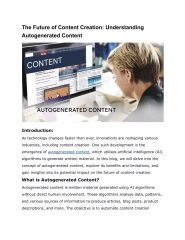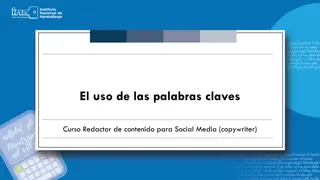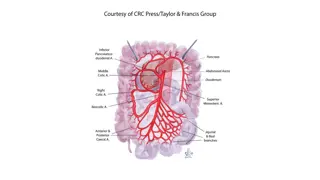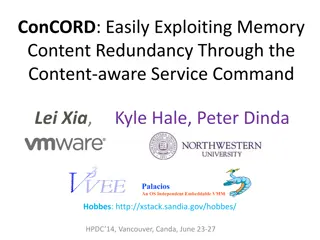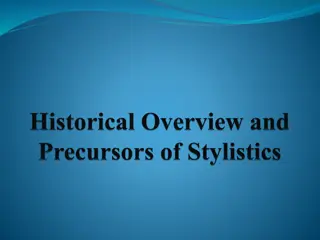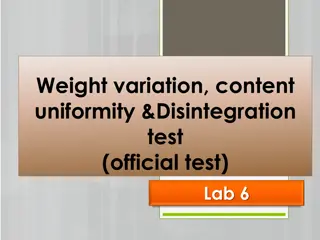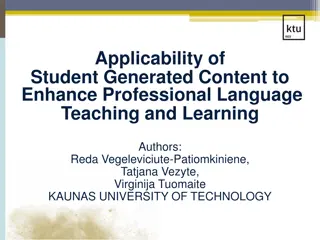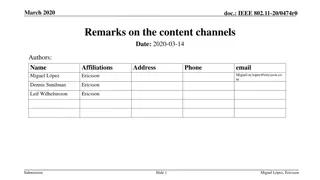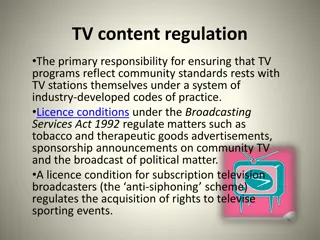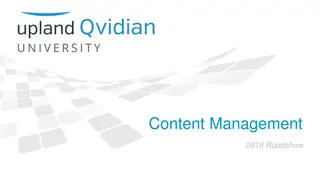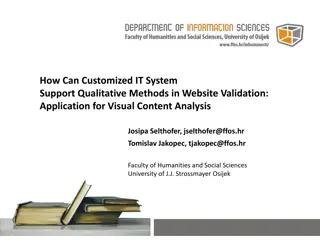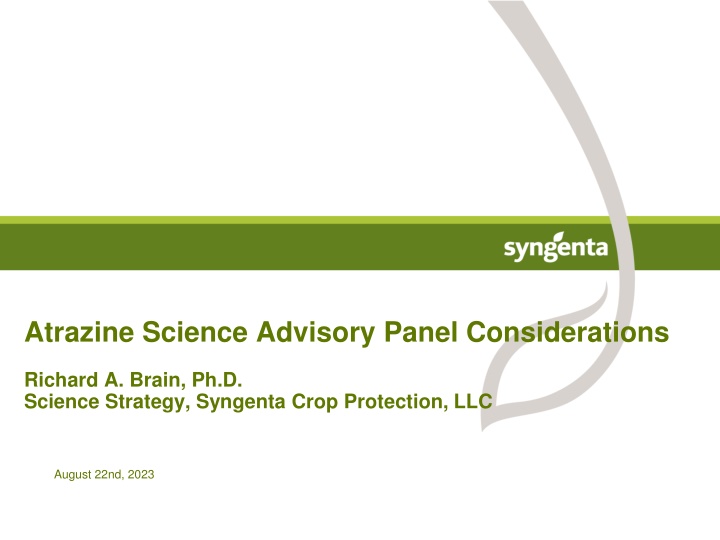
Atrazine Aquatic CE-LOC History and Regulatory Updates
Explore the detailed history of Atrazine Aquatic Constant Exposure Level of Concern (CE-LOC) evaluations, regulatory updates, and scientific analyses. From initial assessments to proposed revisions by the EPA, understand the evolution of CE-LOC values and the impact on aquatic environments. Stay informed on the latest research and decision-making processes surrounding atrazine's effects on plant communities and endangered species.
Download Presentation

Please find below an Image/Link to download the presentation.
The content on the website is provided AS IS for your information and personal use only. It may not be sold, licensed, or shared on other websites without obtaining consent from the author. If you encounter any issues during the download, it is possible that the publisher has removed the file from their server.
You are allowed to download the files provided on this website for personal or commercial use, subject to the condition that they are used lawfully. All files are the property of their respective owners.
The content on the website is provided AS IS for your information and personal use only. It may not be sold, licensed, or shared on other websites without obtaining consent from the author.
E N D
Presentation Transcript
Atrazine Science Advisory Panel Considerations Richard A. Brain, Ph.D. Science Strategy, Syngenta Crop Protection, LLC August 22nd, 2023
Content History of the CE-LOC Nature of the micro/mesocosm dataset The importance of systematic data quality and relevance review Calculation of the CE-LOC Geographic implications associated with the LOC Relevance of data quality and relevance to other taxonomic groups 2
History of Atrazine Aquatic Constant Exposure Level of Concern (CE-LOC) Existing LOC 18 ppb. SAPs (2007 and 2009) evaluate potential atrazine aquatic plant community impacts and LOC using CASM model calibrated with cosm study results. 2004 - 2011 September 2011 OPP announces estimated LOC 10 ppb (60 days), based on PATI model calibrated with cosm study results. EFED transitions from Brock scores to binary scoring and re-evaluates cosm dataset. SAP evaluates cosm endpoints and PATI model, finds EPA s updated proposed LOC of 4-7 ppb (60 days) relies on invalid studies and improper scoring; agrees with the cosm scoring in Giddings et al. 2012; and recommends conduct of a higher-tiered simulated stream study. 2012 Peer-review publication of higher-tiered study by King et al. using simulated streams, no effects of pulsed exposures up to 150 ppb (30 ppb for 60 day avg) January 2016 Draft Ecological Risk Assessment suggests CE-LOC of 3.4 ppb (60 days). EPA announced that it will have atrazine's [draft] assessment peer reviewed by the Scientific Advisory Panel in 2017 - which it never did. June 2016 3
History of Atrazine Aquatic CE-LOC (Continued) Detailed comments by Syngenta and others on science supporting significantly higher CE-LOC, including published scientific analyses. October 2016 November 2016 Peer-review publication of weight of the evidence and data quality analysis by Moore et al., supports LOC of approximately 20 ppb. Peer-review publication of updated weight of the evidence and data quality analysis by Giddings et al. supports LOC of approximately 20 ppb. April 2018 Regulatory update by EPA adopts cosm scoring and study exclusions recommended by 2012 SAP, applies uncertainty analysis, revises CE- LOC to 15 ppb (60 days). October 2019 Atrazine PID confirms CE-LOC of 15 ppb (60 days). EPA provides minimal responses to public comments and more recent studies and commits to responding fully as part of Biological Evaluation process. EFED s cosm scoring database and PATI simulations were not provided for review. January 2020 Detailed comments by Syngenta and others on science, including published scientific analyses, confirming 15 ppb (60 days) is highly conservative. March 2020 4
History of Atrazine Aquatic CE-LOC (Continued) September 2020 Atrazine ID states that the Agency s decision to use the concentration of 15 ppb as a 60-day average for the CE-LOC has not changed. November 2020 EPA issues draft biological evaluation (BE), does not incorporate the CE-LOC Peer-review publication of assessment of potential atrazine risks to endangered species by Smith et al., supports LOC of 50 ppb. July 2021 EPA files motion for remand, announcing agency reconsideration of CE-LOC August 2021 EPA issues Proposed Revisions to the Atrazine ID that include adoption of the 3.4 ppb CE-LOC based on the June 2016 assessment, recharacterize the 15 ppb CE-LOC as a policy decision, and provide no additional or updated substantive scientific assessment. June 2022 EPA releases White Paper, a robust re-evaluation of 11 cosm studies, providing detailed scientific support for EPA s updated determinations on inclusion and scoring of the endpoints from these studies. July 2023 5
Nature of the Micro/Mesocosm Dataset The Atrazine Micro/Mesocosm Dataset is Comprised of 40 Studies Not all studies are created equal Intensive and systematic review should be applied to all 40 studies, not just the 11 identified by the 2012 SAP 6
Example Results From King et al., 2016 Algal biomass response to atrazine treatments by day of experiment: (A) ash-free dry mass (grams per square meter) and (B) chlorophyll a (milligrams per square meter). Gray-filled polygons represent relative mean atrazine pulses by day of experiment. AFDM = ash-free dry mass; CHLA = chlorophyll a. 7
Recommended Sources https://www.regulations.gov/comment/EPA-HQ-OPP-2023-0154-0018 Giddings J, Campana D, Nair S, Brain R. 2018. Data quality scoring system for microcosm and mesocosm studies used to derive a Level of Concern for atrazine. Integrated Environmental Assessment and Management 14(4):489-497. Moore DRJ, Greer CD, Manning G, Wooding K, Beckett KJ, Brain RA, Marshall G. 2017. A weight-of-evidence approach for deriving a level of concern for atrazine that is protective of aquatic plant communities. Integrated Environmental Assessment and Management 13(4):686-701. Smith PN, Armbrust KL, Chen W, Brain RA, Galic N, Ghebremichael L, Giddings JM, Hanson ML, Maul JD, Van Der Kraak G, Solomon KR. 2021. Assessment of risks to listed species from the use of atrazine in the USA: A perspective. Journal of Toxicology and Environmental Health Part B 24(6):223-306 DOI: https://www.tandfonline.com/doi/full/10.1080/10937404.2021.1902890. King RS, Brain RA, Back JA, Becker C, Wright MV, Toteu Djomte V, Scott WC, Virgil SR, Brooks BW, Hosmer AJ, Chambliss CK. 2015. Effects of pulsed atrazine exposures on autotrophic community structure, biomass, and production in field-based stream mesocosms. Environmental Toxicology and Chemistry 35(3): 660 675. 8
The Importance of Systematic Data Quality and Relevance Review The application of consistent and systematic quality and relevance standards is essential to ensure that the best available data is utilized to support risk assessment conclusions. Reliance on data of lesser quality or relevance not only increases uncertainty but can also lead to inappropriate and/or unnecessary mitigations by risk managers, which can further result in significant agronomic challenges for growers. A priori development, agreement, and application of systematic quality and relevance standards is imperative to ensure the most accurate interpretation of this database regarding the generation of an aquatic level of concern (LOC). EPA should consider implementing a more systematic data quality evaluation of each study and data point and incorporating the results into any meta-analysis. 9
Recommended Sources https://www.regulations.gov/comment/EPA-HQ-OPP-2023-0154-0018 Giddings J, Campana D, Nair S, Brain R. 2018. Data quality scoring system for microcosm and mesocosm studies used to derive a Level of Concern for atrazine. Integrated Environmental Assessment and Management 14(4):489-497. Moore DRJ, Greer CD, Manning G, Wooding K, Beckett KJ, Brain RA, Marshall G. 2017. A weight-of-evidence approach for deriving a level of concern for atrazine that is protective of aquatic plant communities. Integrated Environmental Assessment and Management 13(4):686-701. Giddings J.2022. Atrazine: Reanalysis of the Level of Concern Based on Mesocosm Data. Compliance Services International, 7501 Bridgeport Way West, Lakewood, WA 98499, USA. Report Number: 22723. MRID 51885101. USEPA [United States Environmental Protection Agency] 2023. White Paper in Support of the Meeting of the FIFRA Scientific Advisory Panel on the Examination of Mesocosm and Microcosm Studies for Evaluating the Effects of Atrazine on Aquatic Plant Communities. Environmental Fate and Effects Division, Office of Pesticide Programs, U.S. Environmental Protection Agency, August 22-24, 2023. Klimisch HJ, Andreae M, Tillmann U. 1997. A systematic approach for evaluating the quality of experimental toxicological and ecotoxicological data. Regulatory Toxicology and Pharmacology 25:1 5. Hanson M, Baxter L, Anderson J, Solomon K, Brain R. 2019. Strength of Methods Assessment for Aquatic Primary Producer Toxicity Data: A Critical Review of Atrazine Studies from the Peer-reviewed Literature. Science of the Total Environment https://doi.org/10.1016/j.scitotenv.2019.04.336 Hanson M, Brain R. 2021. A method to screen for consistency of effect from Anuran laboratory toxicity tests: A case study with the herbicide atrazine. Archives of Environmental Contamination and Toxicology 81(1):123-132. https://doi.org/10.1007/s00244-021-00847-x. Van Der Kraak, G.J., Hosmer, A.J., Hanson, M.L., Kloas, W., Solomon, K.R., 2014. Effects of atrazine in fish, amphibians, and reptiles: an analysis based on quantitative weight of evidence. Crit. Rev. Toxicol. 44 (Suppl. 5), S1 S66. 10
CE-LOC Analysis: PATI and Direct Cosm Regression Analysis Based on Appendix G from EPA, 2016 and Appendix A from Keigwin, 2019 PATI and Direct Cosm Regression Analysis Based on Appendix G from EPA, 2016 and Appendix A from Keigwin, 2019 # of LOCPATI (%Effect- Day) 85.7 107.0 128.8 98.5 87.1 104.6 112.7 128.5 161.8 259.2 297.9 60-D LOCppbd (PPB-D) 176.8 224.1 273.0 190.3 180.0 222.2 239.4 279.8 352.7 574.8 668.7 % Increase over EPA Base Case NA 127 154 108 102 126 135 158 199 325 378 Cosms in Cosm Set 86 85 84 86 78 82 86 86 72 86 72 CELOC (PPBD) 2.95 3.74 4.55 3.17 3.00 3.70 3.99 4.66 5.88 9.58 11.15 Alternative Scenario 0 EPA, 2016 - Base Case Scenario 1 EPA, 2016 - Base CaseExcluding Cosm ID# 58b Scenario 2 Keigwin Memo, Appendix A, Exclude IDs #58 and 58b (same as EPA 2016-L) Scenario 3 Keigwin Memo, Appendix A, Classify ID #s 1, 2, 3, 4, 5, 41, 42, 52 as No Effect Scenario 4 Keigwin Memo, Appendix A, Exclude ID #s 1, 2, 3, 4, 5, 41, 42, 52 Scenario 5 Keigwin Memo, Appendix A, Exclude ID #s 22, 23, 24, and 25 Scenario 6 Keigwin Memo, Appendix A, Classify ID #s 28 and 44 as No Effect Scenario 7 Keigwin Memo, Appendix A, Classify ID #s 83, 84, 85, 86, and 87 as No Effect Scenario 8 Scenrios, 2, 4, and 5 (Exclude only) Scenario 9 Scenarios 3, 6, and 7 (Classify as No Effect only) Scenario 10 Scenarios 2, 4, 5, 6, and 7 (Exclusions and Classify as No Effect combined) Scenario 112012 SAP - Exclude ID#s 58, 58b, 22, 23, 24, 25 & Classify ID#s 1, 2, 3, 4, 5, 28, 41, 42, 44, 52, 83, 84, 85, 86, and 87 as No Effect Scenario description relative to 2016 EPA Base Case (Scenario 0) CELOC 2.95 3.72 4.50 3.42 3.01 3.65 3.93 4.50 5.64 8.95 10.30 80 452.9 15.24 1064.9 17.75 602 11
CE-LOC Analysis: PATI and Direct Cosm Regression Analysis Based on Appendix G from EPA, 2016 and Appendix A from Keigwin, 2019 (Continued) CE-LOC Comparison of EPA, 2016 Base Case and 2012 SAP Recommendations PATI-Derived CE- LOC = 2.95 ppb EPA, 2016 - Base Case 2012 SAP - Exclude ID#s 58, 58b, 22, 23, 24, 25 & Classify ID#s 1, 2, 3, 4, 5, 28, 41, 42, 44, 52, 83, 84, 85, 86, and 87 as No Effect PATI-Derived CE-LOC = 15.24 ppb 12
Geographic Implications of the Level of Concern For the purposes of illustration, predictions of the maximum 60-day rolling average concentration for atrazine are provided and represent the standard (median) output from the WARP-MP model using the correct total rainfall values as an explanatory/input variable. LOC of 15 g/L impacts 6% of national corn LOC of 3.4 g/L impacts 41% of national corn 13
Relevance of Data Quality for Other Taxa (Amphibians) Since 2003, EPA has written numerous white papers, held 3 FIFRA SAPs (2003, 2007, 2012) Under the Agency s direction and supervision, a rigorous definitive amphibian study was submitted in 2007 (MRID 47153501; Kloas et al. 2009), showing that the results of the earlier, questionable studies were not repeatable and demonstrated no significant effects at all tested concentrations (0.01 100 g/L). Until the 2016 draft ERA, The Agency held to the principle that only quality studies would be used to determine the potential effects of atrazine on amphibians, specifically, studies that are used quantitatively must be of sufficient quality EPA conducted another comprehensive review in 2012 and concluded that EPA does not have additional data on amphibians that is sufficient and robust which alters its quantitative understanding of the potential toxicity of atrazine to this taxon. However, the 2012 SAP recommended EPA conduct a rigorous weight of evidence analysis that incorporated study quality concerns without overreliance on a single study The 2016 Draft ERA disregarded study quality concerns, including previous determinations by EPA and the SAP, to arrive at a low and inaccurate endpoint for amphibians of 3.4 g/L. EPA acknowledged that the individual study quality concerns were deemed less important and that emphasis was placed on interpreting the range of reported results across all of the studies. A weight of evidence approach should systematically review study quality and relevance and weight the data accordingly (this would indicate a chronic endpoint closer to 100 g/L) 14
Relevance of Data Quality for Other Taxa (Fish) Fish Chronic Endpoint (5 g/L): - Based a study (Papoulias et al., 2014) with significant deficiencies Non-GLP (Good Laboratory Practice) o Standard protocol not followed (study conducted in 2004 prior to OECD 229) o Sex ratios of 4 :1 , equal numbers (4 or 5) are recommended o Overall low egg production (4-10 fold < reported in other studies) for all treatments o Overall high 24 h egg mortality (35-45%) for all treatments o Implausible proposed Mode of Action Phosphodiesterase (PDE) inhibition o Study was conducted in 2004, not published until 2014 (10 years later) - The Agency s data evaluation record (DER) outlines these deficiencies in detail and characterizes the study as qualitative - A GLP compliant study (EPA MRID 49694001; Hosmer et al. 2017) contradicted the results of the Papoulias et al (2014 study) - The DER for MRID 49694001 (Hosmer et al. 2017) corroborates the study conclusions of no statistically significant or biologically significant effects for any endpoint assessed at any exposure level (0.6, 5.5, and 53 g/L). - Papoulias DM, Tillitt DE, Talykina MG, Whyte JJ, Richter CA. 2014. Atrazine reduces reproduction in Japanese medaka (Oryzias latipes). Aquat Toxicol. 154:230 239. - Hosmer AJ; Schneider SZ; Anderson JC; Knopper LD; and Brain RA. 2017. Fish Short-Term Reproduction Assay (FSTRA) with Atrazine and the Japanese Medaka (Oryzias latipes). Environmental Toxicology and Chemistry 36(9):2327-2334. o 15
Recommended Sources Mark L. Hanson, Keith R. Solomon, Glen J. Van Der Kraak & Richard A. Brian (2019) Effects of atrazine on fish, amphibians, and reptiles: update of the analysis based on quantitative weight of evidence, Critical Reviews in Toxicology, 49:8, 670-709, DOI:10.1080/10408444.2019.1701985. Van Der Kraak GJ, Hosmer AJ, Hanson ML, Kloas W, Solomon KR. 2014.Effects of atrazine in fish, amphibians, and reptiles: an analysis based on quantitative weight of evidence. Crit Rev Toxicol. 44:1 66. Hosmer AJ; Schneider SZ; Anderson JC; Knopper LD; and Brain RA. 2017. Fish Short- Term Reproduction Assay (FSTRA) with Atrazine and the Japanese Medaka (Oryzias latipes). Environmental Toxicology and Chemistry 36(9):2327-2334. Dionne E, Hanson M, Anderson, J, Brain R. 2020. Chronic toxicity of technical atrazine to the fathead minnow (Pimephales promelas) during a full life-cycle exposure and an evaluation of the consistency of responses. Science of the Total Environment 755(2): 142589 https://doi.org/10.1016/j.scitotenv.2020.142589. Brain RA, Schneider SZ, Anderson JC, Knopper LD, Wolfe JC, Hanson ML. 2018. Extended Fish Short Term Reproduction Assays with the Fathead Minnow and Japanese Medaka: No Evidence of Effects from Exposure to Atrazine. Chemosphere 205:126-136. Kloas W, Lutz I, Springer T, Krueger H, Wolf J, Holden L, and Hosmer A. (2009). Does atrazine influence larval development and sexual differentiation in Xenopus laevis? Toxicological Sciences 107(2):376 84. 16
Summary/Key Points The cosm CE-LOC has evolved over time along with the dataset, but has always been between 10-18 ppb (60-d RA), until recently The micro/mesocosm dataset varies considerably in terms of sophistication, rigor, execution, interpretation, design, and consistency and studies should be weighted accordingly Systematic data quality and relevance review is paramount to identifying best available data and ensuring risk assessment and management accuracy The CE-LOC is highly sensitive to the binary delineated (effect/no-effect) cosm dataset, particularly studies purporting effects at low exposures The potential geographic implications associated with the CE-LOC (and WARP model) are widespread, with implications for agriculture When best available data are employed, a CE-LOC is protective of other taxonomic groups (e.g., fish and amphibians) and still conservative 17

